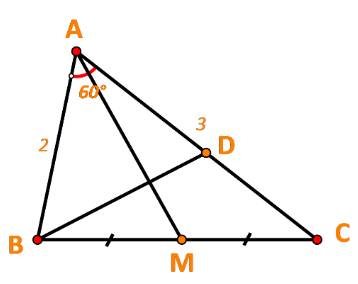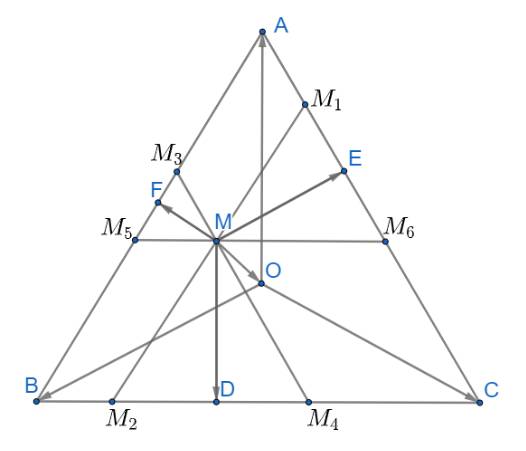Cho tam giác ABC, gọi D và E là điểm xác định bởi \(\overrightarrow{AD}=2\overrightarrow{AB}\) , \(\overrightarrow{AE}=\frac{2}{5}\overrightarrow{AC}\), G là trọng tâm tam giác, biểu diễn \(\overrightarrow{DE}=x\overrightarrow{DG}\). Giá trị x = ...
Hãy nhập câu hỏi của bạn vào đây, nếu là tài khoản VIP, bạn sẽ được ưu tiên trả lời.


1/ \(\overrightarrow{AM}=3\overrightarrow{AM}+\overrightarrow{MB}+\overrightarrow{MC}+\overrightarrow{MD}\)
\(\Leftrightarrow2\overrightarrow{AM}+3\overrightarrow{MG}=\overrightarrow{0}\)
\(\Leftrightarrow2\overrightarrow{AM}+3\overrightarrow{MA}+3\overrightarrow{AG}=\overrightarrow{0}\)
\(\Leftrightarrow\overrightarrow{AM}=3\overrightarrow{AG}\)
Ban tu ket luan
2/ Bạn coi lại đề bài, đẳng thức kia có vấn đề. 2k-1IB??
\(\overrightarrow{IA}+2k-1+\overrightarrow{IB}+k\overrightarrow{IC}+\overrightarrow{ID}=0\)

a: vecto DE
=vecto DA+vecto AE
=-2vecto AB+2/5*vecto AC
vecto DG=vecto DB+vecto BG
=-2*vecto AB-vecto GB
=-2vecto AB-(-vecto GA-vecto GC)
=-2 vecto AB-(vecto CG-vecto GA)
=-2vecto AB-(vecto CG+vecto AG)
=-2vecto AB+vecto GA+vecto GC
=-2*vecto AB+2*vecto GF
=-2vecto AB+2*1/3*vecto BF
=-2*vecto AB+2/3(vecto BA+vecto BC)
=-2vecto AB-2/3vecto AB+2/3*veto BC
=-8/3vecto AB+2/3*(vecto BA+vecto AC)
=-10/3vecto AB+2/3vecto AC
b: vecto DE=-2vecto AB+2/5vecto AC
vecto DG=-10/3vecto AB+2/3*vecto AC
Vì \(\dfrac{-2}{-\dfrac{10}{3}}=2:\dfrac{10}{3}=\dfrac{6}{10}=\dfrac{3}{5}=\dfrac{2}{5}:\dfrac{2}{3}\)
nên D,E,G thẳng hàng


a) \(\overrightarrow {AB} .\overrightarrow {AC} = 2.3.\cos \widehat {BAC} = 6.\cos {60^o} = 3\)
b)
Ta có: \(\overrightarrow {AB} + \overrightarrow {AC} = 2\overrightarrow {AM} \)(do M là trung điểm của BC)
\( \Leftrightarrow \overrightarrow {AM} = \frac{1}{2}\overrightarrow {AB} + \frac{1}{2}\overrightarrow {AC} \)
+) \(\overrightarrow {BD} = \overrightarrow {AD} - \overrightarrow {AB} = \frac{7}{{12}}\overrightarrow {AC} - \overrightarrow {AB} \)
c) Ta có:
\(\begin{array}{l}\overrightarrow {AM} .\overrightarrow {BD} = \left( {\frac{1}{2}\overrightarrow {AB} + \frac{1}{2}\overrightarrow {AC} } \right)\left( {\frac{7}{{12}}\overrightarrow {AC} - \overrightarrow {AB} } \right)\\ = \frac{7}{{24}}\overrightarrow {AB} .\overrightarrow {AC} - \frac{1}{2}{\overrightarrow {AB} ^2} + \frac{7}{{24}}{\overrightarrow {AC} ^2} - \frac{1}{2}\overrightarrow {AC} .\overrightarrow {AB} \\ = - \frac{1}{2}A{B^2} + \frac{7}{{24}}A{C^2} - \frac{5}{{24}}\overrightarrow {AB} .\overrightarrow {AC} \\ = - \frac{1}{2}{.2^2} + \frac{7}{{24}}{.3^2} - \frac{5}{{24}}.3\\ = 0\end{array}\)
\( \Rightarrow AM \bot BD\)

\(\overrightarrow {MD} + \overrightarrow {ME} + \overrightarrow {MF} = \left( {\overrightarrow {MO} + \overrightarrow {OD} } \right) + \left( {\overrightarrow {MO} + \overrightarrow {OE} } \right) + \left( {\overrightarrow {MO} + \overrightarrow {OF} } \right)\)
Qua M kẻ các đường thẳng \({M_1}{M_2}//AB;{M_3}{M_4}//AC;{M_5}{M_6}//BC\)
Từ đó ta có: \(\widehat {M{M_1}{M_6}} = \widehat {M{M_6}{M_1}} = \widehat {M{M_4}{M_2}} = \widehat {M{M_2}{M_4}} = \widehat {M{M_3}{M_5}} = \widehat {M{M_5}{M_3}} = 60^\circ \)
Suy ra các tam giác \(\Delta M{M_3}{M_5},\Delta M{M_1}{M_6},\Delta M{M_2}{M_4}\) đều
Áp dụng tính chất trung tuyến \(\overrightarrow {AM} = \frac{1}{2}\left( {\overrightarrow {AB} + \overrightarrow {AC} } \right)\)(với M là trung điểm của BC) ta có:
\(\overrightarrow {ME} = \frac{1}{2}\left( {\overrightarrow {M{M_1}} + \overrightarrow {M{M_6}} } \right);\overrightarrow {MD} = \frac{1}{2}\left( {\overrightarrow {M{M_2}} + \overrightarrow {M{M_4}} } \right);\overrightarrow {MF} = \frac{1}{2}\left( {\overrightarrow {M{M_3}} + \overrightarrow {M{M_5}} } \right)\)
\( \Rightarrow \overrightarrow {MD} + \overrightarrow {ME} + \overrightarrow {MF} = \frac{1}{2}\left( {\overrightarrow {M{M_2}} + \overrightarrow {M{M_4}} } \right) + \frac{1}{2}\left( {\overrightarrow {M{M_1}} + \overrightarrow {M{M_6}} } \right) + \frac{1}{2}\left( {\overrightarrow {M{M_3}} + \overrightarrow {M{M_5}} } \right)\)
Ta có: các tứ giác \(A{M_3}M{M_1};C{M_4}M{M_6};B{M_2}M{M_5}\) là hình bình hành
Áp dụng quy tắc hình bình hành ta có
\(\overrightarrow {MD} + \overrightarrow {ME} + \overrightarrow {MF} = \frac{1}{2}\left( {\overrightarrow {M{M_2}} + \overrightarrow {M{M_4}} } \right) + \frac{1}{2}\left( {\overrightarrow {M{M_1}} + \overrightarrow {M{M_6}} } \right) + \frac{1}{2}\left( {\overrightarrow {M{M_3}} + \overrightarrow {M{M_5}} } \right)\)
\( = \frac{1}{2}\left( {\overrightarrow {M{M_1}} + \overrightarrow {M{M_3}} } \right) + \frac{1}{2}\left( {\overrightarrow {M{M_2}} + \overrightarrow {M{M_5}} } \right) + \frac{1}{2}\left( {\overrightarrow {M{M_4}} + \overrightarrow {M{M_6}} } \right)\)
\( = \frac{1}{2}\overrightarrow {MA} + \frac{1}{2}\overrightarrow {MB} + \frac{1}{2}\overrightarrow {MC} = \frac{1}{2}\left( {\overrightarrow {MA} + \overrightarrow {MB} + \overrightarrow {MC} } \right)\)
\( = \frac{1}{2}\left( {\left( {\overrightarrow {MO} + \overrightarrow {OA} } \right) + \left( {\overrightarrow {MO} + \overrightarrow {OB} } \right) + \left( {\overrightarrow {MO} + \overrightarrow {OC} } \right)} \right)\)
\( = \frac{1}{2}\left( {3\overrightarrow {MO} + \left( {\overrightarrow {MA} + \overrightarrow {MB} + \overrightarrow {MC} } \right)} \right) = \frac{3}{2}\overrightarrow {MO} \) (đpcm)
Vậy \(\overrightarrow {MD} + \overrightarrow {ME} + \overrightarrow {MF} = \frac{3}{2}\overrightarrow {MO} \)


\(a,\) \(\overrightarrow{IA}=2\overrightarrow{IB}-4\overrightarrow{IC}\)
\(\overrightarrow{IA}=2\overrightarrow{IB}-2\overrightarrow{IC}-2\overrightarrow{IC}=2\overrightarrow{CB}-2\overrightarrow{IC}\)
\(=2\left(\overrightarrow{AB}-\overrightarrow{AC}\right)-2\left(\overrightarrow{AC}-\overrightarrow{AI}\right)\)
\(\overrightarrow{IA}=2\overrightarrow{AB}-2\overrightarrow{AC}-2\overrightarrow{AC}+2\overrightarrow{AI}\)
\(\overrightarrow{IA}=\dfrac{2}{3}\overrightarrow{AB}-\dfrac{4}{3}\overrightarrow{AC}\)
\(b,\overrightarrow{IJ}=\overrightarrow{AJ}-\overrightarrow{AI}=\dfrac{2}{3}\overrightarrow{AB}+\overrightarrow{IA}=\dfrac{2}{3}\overrightarrow{AB}+\dfrac{2}{3}\overrightarrow{AB}-\dfrac{4}{3}\overrightarrow{AC}=\dfrac{4}{3}\left(\overrightarrow{AB}-\overrightarrow{AC}\right)\left(1\right)\)
\(\overrightarrow{JG}=\overrightarrow{AG}-\overrightarrow{AJ}=\dfrac{2}{3}\overrightarrow{AM}-\dfrac{2}{3}\overrightarrow{AB}\)\((\) \(\) \(M\) \(trung\) \(điểm\) \(BC)\)
\(\overrightarrow{JG}=\dfrac{\overrightarrow{AB}+\overrightarrow{AC}}{3}-\dfrac{2}{3}\overrightarrow{AB}=-\dfrac{1}{3}\overrightarrow{AB}+\dfrac{1}{3}\overrightarrow{AC}=-\dfrac{1}{3}\left(\overrightarrow{AB}-\overrightarrow{AC}\right)\left(2\right)\)
\(\left(1\right)\left(2\right)\Rightarrow\overrightarrow{IJ}=-4\overrightarrow{JG}\Rightarrow I,J,G\) \(thẳng\) \(hàng\)
\(\overrightarrow{DE}=\overrightarrow{DA}+\overrightarrow{AE}=-2\overrightarrow{AB}+\frac{2}{5}\overrightarrow{AC}\)
\(\overrightarrow{DG}=\overrightarrow{DA}+\overrightarrow{AG}=-2\overrightarrow{AB}+\frac{1}{3}\overrightarrow{AB}+\frac{1}{3}\overrightarrow{AC}=-\frac{5}{3}\overrightarrow{AB}+\frac{1}{3}\overrightarrow{AC}=\frac{5}{6}\left(-2\overrightarrow{AB}+\frac{2}{5}\overrightarrow{AC}\right)\)
\(\Rightarrow\overrightarrow{DG}=\frac{5}{6}\overrightarrow{DE}\Rightarrow\overrightarrow{DE}=\frac{6}{5}\overrightarrow{DG}\Rightarrow x=\frac{6}{5}\)